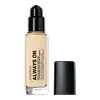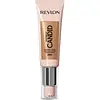Smashbox Always On Skin-Balancing Foundation Versus Revlon PhotoReady Candid Anti-Pollution Foundation
What's inside
What's inside
 Key Ingredients
Key Ingredients

 Benefits
Benefits

 Concerns
Concerns

 Ingredients Side-by-side
Ingredients Side-by-side

Water
Skin ConditioningDimethicone
EmollientTrimethylsiloxysilicate
EmollientMethyl Trimethicone
Skin ConditioningPhenyl Trimethicone
Skin ConditioningPEG-9 Polydimethylsiloxyethyl Dimethicone
EmulsifyingButylene Glycol
HumectantGlycerin
HumectantMagnesium Sulfate
Silica
AbrasiveCaprylic/Capric Triglyceride
MaskingSodium Hyaluronate
HumectantSalicornia Herbacea Extract
Skin ConditioningTocopheryl Acetate
AntioxidantSaccharide Isomerate
HumectantLaminaria Saccharina Extract
Skin ProtectingPolysilicone-11
Polymethylsilsesquioxane
Glycyrrhiza Inflata Root Extract
Skin ConditioningBetaine
HumectantPullulan
Polyglutamic Acid
Skin ConditioningDipropylene Glycol
HumectantTriethoxycaprylylsilane
Jania Rubens Extract
Skin ConditioningSodium Carrageenan
Emulsion StabilisingPolyglyceryl-3 Diisostearate
EmulsifyingDisteardimonium Hectorite
StabilisingTriethyl Citrate
MaskingSodium Polyacryloyldimethyl Taurate
Emulsion StabilisingCetyl PEG/PPG-10/1 Dimethicone
EmulsifyingDimethicone/PEG-10/15 Crosspolymer
Xanthan Gum
EmulsifyingSilica Dimethicone Silylate
AbsorbentLaureth-7
EmulsifyingAlumina
AbrasiveBHT
AntioxidantSodium Citrate
BufferingCitric Acid
BufferingPhenoxyethanol
PreservativeSodium Dehydroacetate
PreservativeCI 77891
Cosmetic ColorantCI 77491
Cosmetic ColorantCI 77492
Cosmetic ColorantCI 77499
Cosmetic ColorantWater, Dimethicone, Trimethylsiloxysilicate, Methyl Trimethicone, Phenyl Trimethicone, PEG-9 Polydimethylsiloxyethyl Dimethicone, Butylene Glycol, Glycerin, Magnesium Sulfate, Silica, Caprylic/Capric Triglyceride, Sodium Hyaluronate, Salicornia Herbacea Extract, Tocopheryl Acetate, Saccharide Isomerate, Laminaria Saccharina Extract, Polysilicone-11, Polymethylsilsesquioxane, Glycyrrhiza Inflata Root Extract, Betaine, Pullulan, Polyglutamic Acid, Dipropylene Glycol, Triethoxycaprylylsilane, Jania Rubens Extract, Sodium Carrageenan, Polyglyceryl-3 Diisostearate, Disteardimonium Hectorite, Triethyl Citrate, Sodium Polyacryloyldimethyl Taurate, Cetyl PEG/PPG-10/1 Dimethicone, Dimethicone/PEG-10/15 Crosspolymer, Xanthan Gum, Silica Dimethicone Silylate, Laureth-7, Alumina, BHT, Sodium Citrate, Citric Acid, Phenoxyethanol, Sodium Dehydroacetate, CI 77891, CI 77491, CI 77492, CI 77499
Water
Skin ConditioningCyclopentasiloxane
EmollientDimethicone
EmollientPhenyl Trimethicone
Skin ConditioningPEG-9 Polydimethylsiloxyethyl Dimethicone
EmulsifyingTrimethylsiloxysilicate
EmollientButylene Glycol
HumectantPolymethylsilsesquioxane
Polysilicone-11
Hdi/Trimethylol Hexyllactone Crosspolymer
Aloe Barbadensis Leaf Extract
EmollientAluminum Starch Octenylsuccinate
AbsorbentCamellia Sinensis Leaf Extract
AntimicrobialCucumis Sativus Fruit Extract
EmollientDimethicone/PEG-10/15 Crosspolymer
Disteardimonium Hectorite
StabilisingEthylene Brassylate
MaskingLaureth-7
EmulsifyingLecithin
EmollientMagnesium Sulfate
Maris Sal
Skin ConditioningMethicone
EmollientMica
Cosmetic ColorantPolyglyceryl-3 Diisostearate
EmulsifyingPullulan
Sclerotium Gum
Emulsion StabilisingSilica
AbrasiveSodium Ascorbyl Phosphate
AntioxidantSodium Carrageenan
Emulsion StabilisingTetrasodium EDTA
Tocopherol
AntioxidantTocopheryl Acetate
AntioxidantTriethyl Citrate
MaskingXanthan Gum
EmulsifyingCaprylyl Glycol
EmollientPhenoxyethanol
PreservativeIron Oxides
CI 77891
Cosmetic ColorantWater, Cyclopentasiloxane, Dimethicone, Phenyl Trimethicone, PEG-9 Polydimethylsiloxyethyl Dimethicone, Trimethylsiloxysilicate, Butylene Glycol, Polymethylsilsesquioxane, Polysilicone-11, Hdi/Trimethylol Hexyllactone Crosspolymer, Aloe Barbadensis Leaf Extract, Aluminum Starch Octenylsuccinate, Camellia Sinensis Leaf Extract, Cucumis Sativus Fruit Extract, Dimethicone/PEG-10/15 Crosspolymer, Disteardimonium Hectorite, Ethylene Brassylate, Laureth-7, Lecithin, Magnesium Sulfate, Maris Sal, Methicone, Mica, Polyglyceryl-3 Diisostearate, Pullulan, Sclerotium Gum, Silica, Sodium Ascorbyl Phosphate, Sodium Carrageenan, Tetrasodium EDTA, Tocopherol, Tocopheryl Acetate, Triethyl Citrate, Xanthan Gum, Caprylyl Glycol, Phenoxyethanol, Iron Oxides, CI 77891
Ingredients Explained
These ingredients are found in both products.
Ingredients higher up in an ingredient list are typically present in a larger amount.
Butylene Glycol (or BG) is used within cosmetic products for a few different reasons:
Overall, Butylene Glycol is a safe and well-rounded ingredient that works well with other ingredients.
Though this ingredient works well with most skin types, some people with sensitive skin may experience a reaction such as allergic rashes, closed comedones, or itchiness.
Learn more about Butylene GlycolCi 77891 is a white pigment from Titanium dioxide. It is naturally found in minerals such as rutile and ilmenite.
It's main function is to add a white color to cosmetics. It can also be mixed with other colors to create different shades.
Ci 77891 is commonly found in sunscreens due to its ability to block UV rays.
Learn more about CI 77891Dimethicone is a type of synthetic silicone created from natural materials such as quartz.
What it does:
Dimethicone comes in different viscosities:
Depending on the viscosity, dimethicone has different properties.
Ingredients lists don't always show which type is used, so we recommend reaching out to the brand if you have questions about the viscosity.
This ingredient is unlikely to cause irritation because it does not get absorbed into skin. However, people with silicone allergies should be careful about using this ingredient.
Note: Dimethicone may contribute to pilling. This is because it is not oil or water soluble, so pilling may occur when layered with products. When mixed with heavy oils in a formula, the outcome is also quite greasy.
Learn more about DimethiconeDimethicone/PEG-10/15 Crosspolymer is a type of silicone.
Disteardimonium Hectorite comes from the clay mineral named hectorite. It is used to add thickness to a product.
It can also help stabilize a product by helping to disperse other ingredients.
Hectorite is a rare, white clay mineral.
Learn more about Disteardimonium HectoriteLaureth-7 is created by the ethoxylation of lauryl alcohol using ethylene oxide. Lauryl alcohol is a fatty alcohol with hydrating properties.
This ingredient is an emulsifier and cleansing ingredient. As an emulsifier, it is used to prevent ingredients from separating. It also helps cleanse the skin by gathering dirt, oil, and pollutants to be rinsed away.
Magnesium Sulfate is a salt. More specifically, it is an epsom salt, or the bath salt used to help relieve muscle aches.
Despite having ‘sulfate’ in the name, it isn’t a surfactant or cleansing agent like sodium lauryl sulfate. Unlike those sulfates, magnesium sulfate doesn’t have the same cleansing or foaming properties (it's simply a type of salt).
In cosmetics, Magnesium Sulfate is used to thicken a product or help dilute other solids. It is a non-reactive and non-irritating ingredient.
One study shows magnesium deficiency may lead to inflammation of the skin. Applying magnesium topically may help reduce inflammation.
You can find this ingredient in sea water or mineral deposits.
Learn more about Magnesium SulfatePEG-9 Polydimethylsiloxyethyl Dimethicone is a type of silicone.
Phenoxyethanol is a preservative that has germicide, antimicrobial, and aromatic properties. Studies show that phenoxyethanol can prevent microbial growth. By itself, it has a scent that is similar to that of a rose.
It's often used in formulations along with Caprylyl Glycol to preserve the shelf life of products.
Phenyl Trimethicone is a silicon-based polymer. It is derived from silica.
Phenyl Trimethicone is used as an emollient and prevents products from foaming.
As an emollient, it helps trap moisture in the skin. It is considered an occlusive.
Learn more about Phenyl TrimethiconePolyglyceryl-3 Diisostearate is an emulsifer and emollient. It comes from Isostearic Acid and Polyglycerin-3.
As an emulsifier, it helps stabilize products by preventing oils and water from separating.
This ingredient may not be Malassezia folliculitis, or fungal acne safe.
Learn more about Polyglyceryl-3 DiisostearatePolymethylsilsesquioxane is a silicone used as a film forming agent.
When applied to the skin, this ingredient creates an invisible film on the surface. This film still allows oxygen to pass through, but prevents moisture from escaping. This can help condition and hydrate the skin. It also leaves a silky feel when applied.
Polymethylsilsesquioxane has not been shown to clog pores. It has been deemed safe to use up to 55%, but most cosmetics use much less.
If you have concerns about using this ingredient, we recommend speaking with a professional.
Learn more about PolymethylsilsesquioxanePolysilicone-11 is a film-forming silicone that creates a non-tacky and matte finish on the skin. It's commonly used to improve texture, absorb excess oil, and help active ingredients spread evenly.
Due to its "rubber-like" structure, it stays on the skin's surface instead of being absorbed. On the skin, it creates a flexible layer that enhances wearability and stability.
Pullulan is a low viscosity polysaccharide (a long chain carbohydrate) with binding and film forming properties when dissolved in water. It is used to create a "silicone-like" or silky feel in cosmetics without adding viscosity.
According to a manufacturer, this ingredient's ability to easily dissolves makes it a great carrier for active ingredients.
Due to it being edible and tasteless, you'll likely find this ingredient in breath freshener strips. This ingredient is produced from the starch of the fungus, Aureobasidium pullulans.
Pullulan is stable over a broad-range of pH.
Learn more about PullulanSilica, also known as silicon dioxide, is a naturally occurring mineral. It is used as a fine, spherical, and porous powder in cosmetics.
Though it has exfoliant properties, the function of silica varies depending on the product.
The unique structure of silica enhances the spreadability and adds smoothness, making it a great texture enhancer.
It is also used as an active carrier, emulsifier, and mattifier due to its ability to absorb excess oil.
In some products, tiny microneedles called spicules are made from silica or hydrolyzed sponge. When you rub them in, they lightly polish away dead skin layers and enhance the penetration of active ingredients.
Learn more about SilicaWe don't have a description for Sodium Carrageenan yet.
Tocopheryl Acetate is AKA Vitamin E. It is an antioxidant and protects your skin from free radicals. Free radicals damage the skin by breaking down collagen.
One study found using Tocopheryl Acetate with Vitamin C decreased the number of sunburned cells.
Tocopheryl Acetate is commonly found in both skincare and dietary supplements.
Learn more about Tocopheryl AcetateTriethyl Citrate comes from citric acid. It has masking, perfuming, and solvent properties. As a solvent, this ingredient helps disperse ingredients evenly in skincare.
One manufacturer claims this ingredient can:
According to perfume manufacturers, this ingredient is almost odorless but has a mild fruity, wine and plum scent. It can be used to mask the scent of other ingredients.
This ingredient can be plant-sourced or synthetic; it can naturally be found in cabbage and white wine.
Learn more about Triethyl CitrateThis silicone is an emollient. Emollients create a thin film on the skin to prevent moisture from escaping.
It is not soluble in water and helps increase water-resistance in products.
According to a manufacturer, it can blend seamlessly with silicone oils, such as Cyclopentasiloxane.
Learn more about TrimethylsiloxysilicateWater. It's the most common cosmetic ingredient of all. You'll usually see it at the top of ingredient lists, meaning that it makes up the largest part of the product.
So why is it so popular? Water most often acts as a solvent - this means that it helps dissolve other ingredients into the formulation.
You'll also recognize water as that liquid we all need to stay alive. If you see this, drink a glass of water. Stay hydrated!
Learn more about WaterXanthan gum is used as a stabilizer and thickener within cosmetic products. It helps give products a sticky, thick feeling - preventing them from being too runny.
On the technical side of things, xanthan gum is a polysaccharide - a combination consisting of multiple sugar molecules bonded together.
Xanthan gum is a pretty common and great ingredient. It is a natural, non-toxic, non-irritating ingredient that is also commonly used in food products.
Learn more about Xanthan Gum